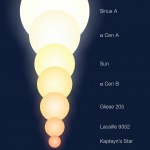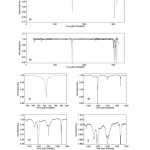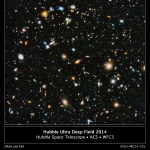astro
The Pale Red Dot project has found a planet.
It is a terrestrial planet, orbiting in the formal habitable zone of Proxima Centauri, the nearest star to the Solar System.
This wide-field image shows the Milky Way stretching across the southern sky. The beautiful Carina Nebula (NGC 3372) is seen at the right of the image glowing in red. It is within this spiral arm of our Milky Way that the bright star cluster NGC 3603 resides. At the centre of the image is the constellation of Crux (The Southern Cross). The bright yellow/white star at the left of the image is Alpha Centauri, in fact a system…
Summer continues, and the public lecture series on physics continues a pace at the Aspen Center for Physics with Dr. Catherine Heymans of the University of Edinburgh talking today on the "Dark Side of the Universe".
The talk is part of one of the three workshops currently taking place:
"Testing the Laws of Gravity with Cosmological Surveys"
"Emergence, Evolution and Effects of Black Holes in the Universe: The Next 50 Years of Black Hole Physics"
"Entanglement Matters"
the public talks are recorded and will, eventually, be available online courtesy of Aspen Grassroots TV, in the meanwhile,…
Tabby's Star - KIC 8462852 - remains one of the more interesting and mysterious objects in the sky.
There is a good update at "Updates on Boyajian’s Star" - Astrowright's blog and "Bradley Schaefer: Further Thoughts on the Dimming of KIC 8462852" at Centauri Dreams has the latest on the controversy over whether the star has undergone long term fading.
Update: "The Most Mysterious Star in the Galaxy" - another guest blog by Schaefer providing a good overview of the issues.
Ultimately to resolve this more data is needed.
There is a Kickstarter Project - "The most mysterious star in the Galaxy…
Yay, NASA Senior Review is out:
SeniorReviewReport_2016
tl;dr - everyone is above average, they're good enough and we like you.
Mission ranks
bad news: per AAAC meeting earlier, there is not enough $ to actually pay for all these lovely toys, so something will have to give, somewhere.
Someone at a high enough pay grade to take the blame will decide whether to cut from the bottom or give everybody a haircut.
Early tealeaf readings are haircuts all around.
Official NASA site for Senior Review + Response
In 2011 Daniel Holz gave a Heinz R. Pagels Public Lecture at the Aspen Center for Physics on the topic of Gravitational Waves. The talk is one of the better explanations of what this is all about, with a bonus introduction!
LIGO and allies have also provided a bunch of fun useful stuff:
Have We Detected Gravitational Waves Yet?
Stretch and Squash
Black Hole Hunter
Einstein@Home
Gravitational Waves 101 - Markus Pössel's excellent visualizations.
The Data
The Papers
SXS - Simulating eXtreme Spacetimes visualizations
The Chirp - courtesy of Georgia Tech GR group
February 11th was a good day.
I spent the day at the "Dynamics and accretion at the Galactic Center" Conference at the Aspen Center for Physics, where about 75 physicists have spent the week talking about black holes and stuff.
This morning we watched the LIGO press conference, frantically deciphered the papers, and had a LIGO Science Collaboration member give us a very good rundown of what the situation is.
Over the last few months, LIGO has been making some very good outreach material to explain what is what:
LIGO: A Passion for Understanding a film by Kai Staats
LIGO: Generations
LIGO…
Ethan Kruse has update the Kepler Orrery, just in time for Extreme Solar Systems III now under way.
Enjoy
The Kepler 2 mission serendipitously observed Neptune about a year ago.
The images were posted on the K2 website, but according to the website stat like nobody shared them, which sucks.
The animation was just shown at the Division for Planetary Sciences meeting, #DPS15, in DC so it is time to show it again.
Enjoy.
Kepler Observes Neptune Dance with Its Moons
Check Emily Lakdwalla's planetary blog for #DPS15 news
As of this morning we have discovered over 1,500 exoplanets, planets orbiting stars other than the Sun.
In addition to the confirmed discoveries, we have over 3,000 candidate exoplanets, most discovered by the NASA Kepler Mission through transits, where we see the shadow of a planet as it crosses in front of its parent star.
We know, statistically, that most of the candidate planets are real, but a few % are weird misalignments of something else that makes us think there might be a planet there. Filtering those out is hard.
We also see other things, weird and wonderful things...
Little over…
Because I must trim browser tabs, here is a current short list of things that might be useful:
Threebody - online implementation of the open source IAS15 integrator - a 15th order high precision N-body integrator -
ASCL - Astrophysics Source Code Library - Open Source Code
Visible Spectra of the Elements - Except Astatine :-(
Astronomy Simulators - small web simulators for elementary concepts.
Some quite nifty.
From University of Nebraska.
All the Kepler 2 Campaign 0 data - with some tools to play with it
Astrophotography is the title of a gorgeous and very useful new book by Thierry Legault
I had to taper off doing book reviews, much to the annoyance of all those lovely people who persist in sending me just the sort of books that I actually really love to read - it just got too time consuming - but, when Rocky Nook told me Thierry Legault had a book on Astrophotgraphy coming out, I agreed to review it immediately.
This is why:
shades of Atlantis
Atlantis
From NASA HQ Photo on Flickr
Thierry Legault is an expert and he takes beautiful photos. He is particularly known for his patient set up…
Day two of the New Frontiers wrap-up conference. This is a slow liveblog with more cosmology and life in the universe. Yesterday's summary is here
A couple of years ago, the Templeton Foundation funded the New Frontiers program to pose "Big Questions" in some areas of science.
This is a slow liveblog - part II will be tomorrow with more cosmology and life in the universe
Seed funding was provided to 20 investigators and small groups to start exploratory research, and, now, it is time to say what they found.
This follows up from the New Frontiers kick-off conference back in 2012.
We start the…
A couple of years ago, the Templeton Foundation funded the New Frontiers program to pose "Big Questions" in some areas of science.
This is a slow liveblog - part II will be tomorrow with more cosmology and life in the universe
Seed funding was provided to 20 investigators and small groups to start exploratory research, and, now, it is time to say what they found.
This follows up from the New Frontiers kick-off conference back in 2012.
The New Frontiers conference to report the hint of the beginning of the draft of the answers is under way... most of the investigators and about half of the…
Some people, with good cause, do not like the phrase "dark side of the Moon".
The reason they do not like it, is because of a common cognitive misconception.
Historically, the phrase refers to the farside of the Moon, which for most of history humanity could not observe, at all, because the Moon is synchronously rotating with the Earth and always presents the same side to the Earth.
The word "dark" here is used in the sense of "hidden" or "unseen", which is a common colloquial use, but, in use then became confused with the more common meaning of "unlit", leading generations of students to…
"There is no dark side of the moon really.
Matter of fact it's all dark."
While the Moon has a nearside and a farside, it does not, actually, have a dark side or a light side, now. At least not a fixed dark side, just a slowly moving night side, and day side.
But it used to. Sorta.
"I remember the first time I saw a globe of the moon as a boy, being struck by how different the farside looks," said Jason Wright, assistant professor of astrophysics. "It was all mountains and craters. Where were the maria? It turns out it's been a mystery since the fifties."
Jason, Arpita Roy a Penn State grad…
"A Hard Rain's A-Gonna Fall on the Dark Side of the Moon..."
The Astrowright has been doing some lunatic slow blogging on an interesting problem:
The Nearside of the Moon
from Ron Hodges - NASA medialibrary
The Farside
from apod
One of these is not like the other...
Jason discusses how we came to be thinking about these things in Part I:
A Hard Rain's A-Gonna Fall on the Dark Side of the Moon I: The Lunar Farside Highlands Problem
It is an interesting problem.
The dichotomy is not superficial
From GRAIL press release 2011
A Hard Rain's A-Gonna Fall on the Dark Side of the Moon II…
Smile, and the whole Universe smiles with you! - A Happy Asterism for #AAS224
A beautiful UV co-added image of the UDF from Hubble
UV UDF
But, if you look closely...
Smile - it could be worse
yet again I trip across a snarky tweet about a distinguished scientist using comic sans
or some other whimsical and easily read on a screen unprofessional and unserious design choice in a presentation
these theological wars are becoming as bad as PC/Mac or emacs/vi flame wars of yore
anyone care to summarise, rationally, and briefly, why serif or sans matters?
Please avoid references to unrepeatable badly controlled A/B studies, and opinion polls of helvetica-phobic graphics designers.


